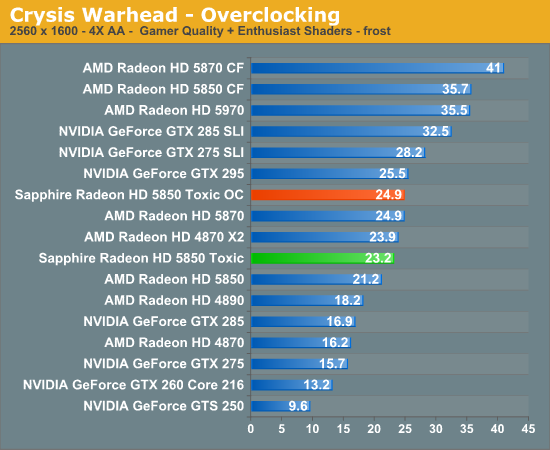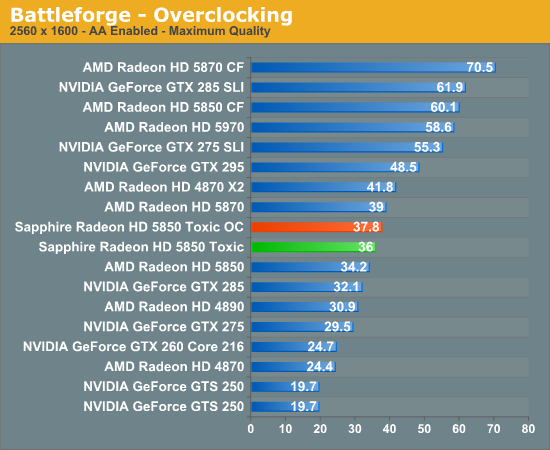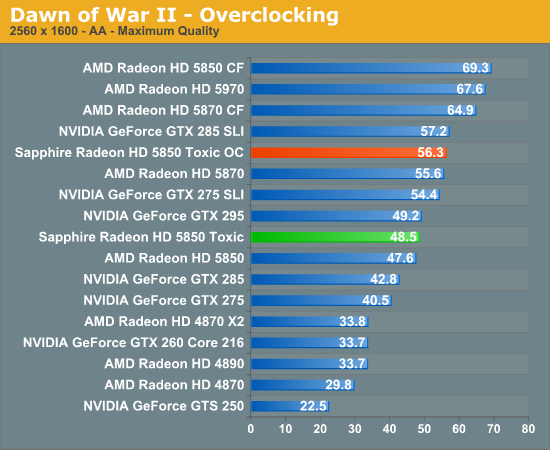Sapphire’s Radeon HD 5850 Toxic Edition: Our First Fully-Custom 5850
by Ryan Smith on February 18, 2010 10:00 PM EST- Posted in
- GPUs
Overclocking
With Sapphire’s superior Vapor-X cooler, the 5850 Toxic is a strong candidate for overclocking. However currently none of our overclocking tools know how to overvolt the card, so any overclocking is limited to what you can get at the 5850’s stock voltage: 1.088v.
With that in mind, we were able to use the AMD GPU Clock Tool to push our card by a further 130MHz on the core to 895MHz, and an additional 50MHz on the memory to 1175MHz. This is 17% core overclock and 4% memory overclock respectively. Thus unlike the already overclocked Toxic card, the games that will respond the best here are those that are GPU limited instead of memory bandwidth limited.



Out of the 3 games we’re taking a look at for overclocking results, the benefit varies wildly. Battleforge is rather insensitive at only a 5% performance increase, while Dawn of War II is nearly linear with the GPU clockspeed increase, for 16%. Thus our results are much like the benefit of Sapphire’s factory overclock in the first place: there’s no rule of thumb, the benefit of overclocking is going to vary wildly depending on the game.
We should note that at these clockspeeds we’re some 23% faster than the 5850’s GPU clock speed, and 17% faster than its memory clock speeds. Thus at these maxed out levels, our further overclocked 5850 Toxic is 17% faster at Crysis, 10% faster at Battleforge, and 18% faster at Battleforge. What’s particularly noteworthy is that the overclocked Toxic actually manages to best the 5870 here, even though the 5870 has another SIMD to work with. This indicates that Battleforge it bottlenecked by the ROPs, or at some point in the fixed-function pipeline.
Temperature, power, and noise results for our overclocked 5850 Toxic are on the next page.










71 Comments
View All Comments
sdhfkjsdhfksjdhfks - Wednesday, March 3, 2010 - link
http://www.dearsales.com">http://www.dearsales.com
Sports, mainly by the advanced sports equipment.
Do you have enough good equipment? Of the world's most famous brands. Only two brands, jordans Nike.
If you want to have these two brands of equipment, and want to use the lowest price to buy,
Then I suggest you go to: http://www.dearsales.com">http://www.dearsales.com
More and more fashionable style. More favorable, the more you want.
Open the wardrobe is not yet found love after another the right clothes? So, also waiting for? Immediate action bar! Welcome to { http://www.dearsales.com">http://www.dearsales.com } sure you will find what you need. Moreover, the company has a good reputation, product quality standards, at reasonable prices. Over the years, has been well received by overseas friends for their support. Therefore, please rest assured purchase.
===== http://www.dearsales.com">http://www.dearsales.com ====